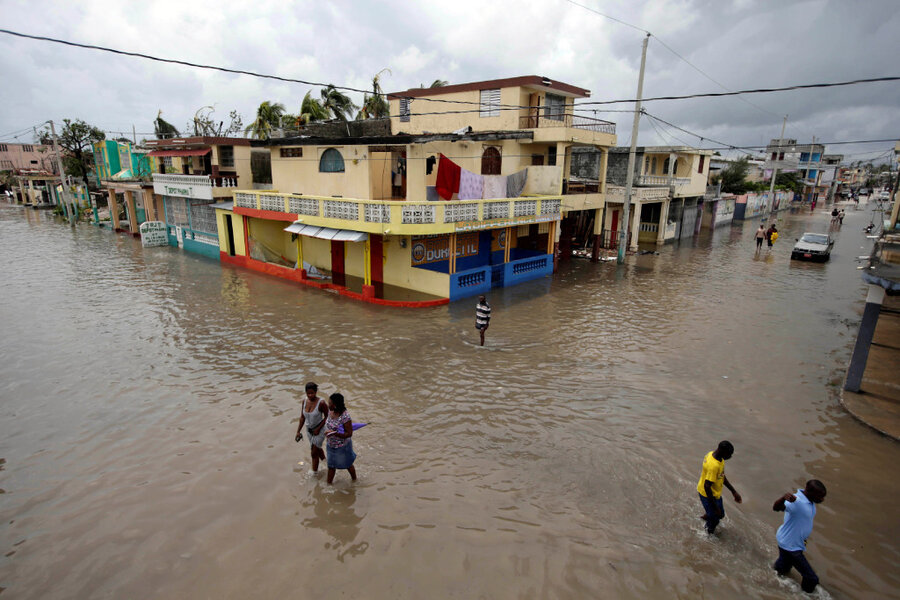Hurricane Matthew: Strongest hurricane to reach Haiti in a generation
Loading...
In just 36 hours hurricane Matthew went from a tropical storm tickling Caribbean islands to a category 5 storm. When it hit Haiti Tuesday, it had weakened into a category 4 story, which Climate Signals still described as the most powerful storm to hit Haiti in a generation.
Hurricane Matthew is now tracking toward the southeastern United States. The storm's 145 mph winds have already caused devastation in Haiti and the Dominican Republic with 40 inches of rainfall in the Dominican Republic and 15 to 25 inches in southern Haiti (the average rainfall in Haiti’s capital city of Port-au-Prince is just 33.68 inches).
The severity of this particular storm cannot be attributed to climate change until an attribution study is conducted, say scientists. But hurricane Matthew reflects a recent pattern of stronger storms due to rising ocean temperatures. And given the Caribbean toll, it also serves as an example of how these hurricanes can disproportionately affect people in low-income communities.
“Since the mid 70s, the number of hurricanes at category 4 and 5 has just about doubled in the north Atlantic region,” Astrid Caldas, a climate scientist at the Union of Concerned Scientists, tells The Christian Science Monitor. This is due in part because “hurricanes need moisture and warm water to develop and because of global warming a lot of extra energy has been absorbed by the oceans and has increased the temperature.”
The resulting temperature increase has been most significant in the Atlantic Ocean. While all the oceans have warmed by about 0.5 degrees Celsius, the Atlantic has warmed more quickly, rising to 0.7 degrees Celsius warmer.
“As the climate warms, the evaporative potential [difference between ocean and atmospheric temperatures] gets larger and hurricanes can theoretically get more powerful,” Kerry Emanuel, professor of atmospheric science at Massachusetts Institute of Technology, tells the Monitor. “That doesn’t mean that they will be more frequent, but we do see tendencies. If you look at statistics you do see a tendency for stronger storms.”
The increase in category 3, 4, and 5 storms that the Atlantic has seen since the 1980s seems more extreme in part because in the 1950 through '80s sulfur pollution from aerosol cans and burning dirty coal actually cooled ocean temperatures and suppressed hurricane activity, a trend that reversed when the Clean Air Act of 1970 was passed, according to Professor Emanuel.
However, the current increase in storms is still being seen as a sign that the climate is changing, by many climate researchers.
Hurricane Matthew's effects will be felt across the Caribbean and into the US, but with a lack of resources, storm mitigation strategies, and information distribution, no communities will feel those effects more than poor communities both at home and abroad.
This has been mirrored around the world with hurricane Katrina in 2005, the earthquake in Nepal in 2015, and the recent flooding in Louisiana among countless other examples.
“If you look at developing countries, you find that concentrations of relatively poor people are in places like river valleys, floodplains, and along the coast where evacuation is more difficult,” Emanuel says.
The two most damaging aspects of hurricanes are the storm surges, tsunami-like waves caused by wind, and freshwater flooding brought on by high volumes of rain, both of which are exacerbated by living close to the coast or in low-elevation inland areas. Living in poverty in isolated regions often makes it more difficult to evacuate when a disaster is coming.
But even in cases where poor people are not geographically concentrated in areas more likely to be a hit by a storm, lower socioeconomic communities still have a harder time dealing with the effects of storms than do wealthy communities.
“The storm arrives where it arrives and there are wealthy people and there are poor people,” Dr. Caldas tells the Monitor. “The wealthy population has the resources and protections and information to ride the storm and to bounce back, but the poor and disadvantaged communities don’t have those resources and so they are hit disproportionately hard.”
This trend was acknowledged by a 2014 report by the United Nation’s Intergovernmental Panel on Climate Change, which stated that “people who are socially, economically, culturally, politically, institutionally, or otherwise marginalized are especially vulnerable to climate change.”
Climate change, while nondiscriminatory in and of itself, is intersectional in that the problems disproportionately affecting poor people are made worse when those poor people are also people of color or members of a disadvantaged minority group.
“That is why the environmental justice movement is gaining so much strength because climate change, and these types of events that can be made worse by climate change, are multipliers of issues that already exist,” Caldas tells the Monitor.






